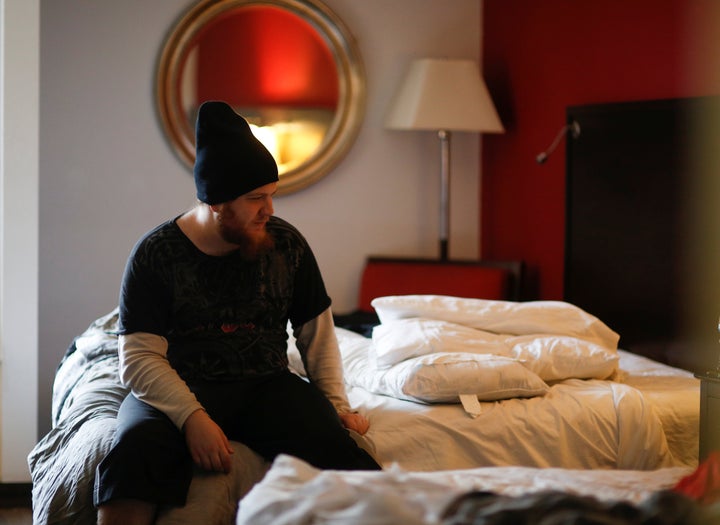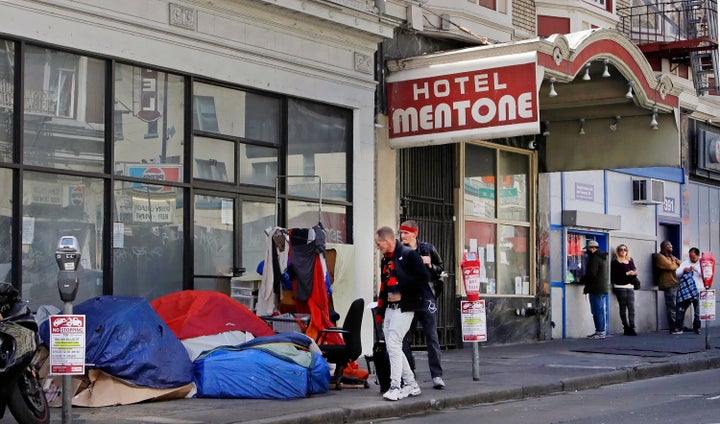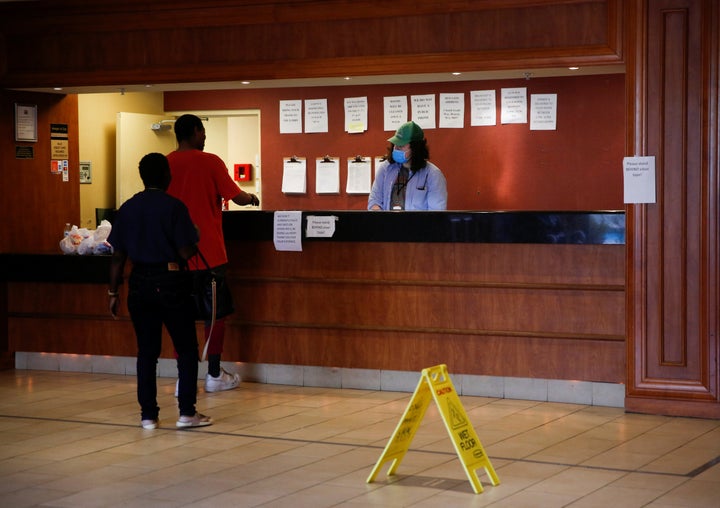[ad_1]
Ordinarily, the atmosphere in the Downtown Emergency Service Center’s main shelter in Seattle was just this side of chaos. During the day, men and women crowded into the community room and hung out in a narrow corridor known as the “bowling alley,” arguing, sleeping and jockeying for space.
At night, the clients settled into metal bunks without pillows or sheets, trying to sleep through the sounds and smells of dozens of other people all around them.
These days, though, the space is quiet. Shortly after the coronavirus pandemic began, DESC began reducing capacity, and in early March, the city moved the remaining 129 residents to an exhibition hall near the Space Needle. One month later, King County moved them to a Red Lion hotel in Renton, a suburb just southeast of Seattle. The move gave them access to real beds, private showers, and three meals a day ― amenities that were unimaginable before COVID-19.
For some, it’s the first time they’ve slept in a bed, in a room with four walls and a door that locks, in years. The difference, both physically and psychologically, is profound. “Staying at the shelter downtown, you’re always at risk. People are stealing from you. There’s junkies shooting up by you. People just want to attack you,” said Michael C., who asked HuffPost to use his first name and last initial only to protect his privacy. “And here it’s a safe place.”
Dan Williams, DESC’s shelter operations manager, said that after staying in the hotel for just a week or so, Michael was unrecognizable ― so much so that Williams followed him down the hallway when he walked in one day, thinking he wasn’t supposed to be there.
“To see this individual, compared to the way that I knew him a month ago, I didn’t know who he was,” Williams said. “His whole presentation was different. He felt comfortable to shower, because it wasn’t in this group setting where anybody could blow through that door at any second.”
I can lay on a queen-size bed. I can relax. I have the opportunity to work on myself, recalibrate, and have some perspective.
Marcus M.
Marcus M., another resident who asked to use his first name and last initial only, said the biggest difference is that he doesn’t have to fight for space or deal with the constant threat of confrontation. He would normally sleep in the shelter’s day room because he found the cavernous bunk room too noisy and chaotic. In the hotel, “I can lay on a queen-size bed. I can relax. I have the opportunity to work on myself, recalibrate, and have some perspective.”
Across the country, local governments are engaged in a debate about the most effective way to shelter people experiencing homelessness during the pandemic. Some have moved people to larger spaces, such as rec centers and convention halls, where they can sleep farther apart in order to reduce the spread of COVID-19. Other places, including Baltimore, New Orleans and San Francisco, have also begun moving homeless people into hotels, usually focusing on those who are over 60 or have underlying health conditions that make them more vulnerable.
It’s not just about what’s safer. At the core of the debate is the question of cost ― hotels are generally more expensive than shelters ― and what it will mean when the pandemic is over.
Shelters have problems that extend beyond the spread of COVID-19. If it turns out that cities could have mobilized quickly to house people all along, it may be hard to justify putting people back in shelters once the immediate crisis is over.

For now, cities are beginning to move toward a hotel model for housing people. But many have struggled to do so efficiently. In late March, the city of San Francisco announced that it would open the George R. Moscone Convention Center as a shelter for 400 people, with mats placed six feet apart and divided by lines of tape ― an arrangement that opponents derided as an indoor concentration camp.
After a week of protests from homeless advocates and city supervisors, the city switched gears, downsizing plans for the shelter and committing to moving more unsheltered people into hotels to meet physical distancing directives. On April 10, the city publicly acknowledged a major COVID-19 outbreak at the Multi-Service Center-South Shelter, the largest shelter in the city.
San Francisco counted more than 17,000 people experiencing homelessness last year using a new method that more than doubled the 8,000 found in the most recent traditional one-night count. Mayor London Breed said in early April that the city would secure 7,000 hotel rooms as temporary shelter, and on April 15, the San Francisco Board of Supervisors unanimously adopted an ordinance directing Breed to increase that to 8,250 hotel rooms. Breed refused to sign the ordinance, saying it didn’t “acknowledge the challenges of operating these sites.”
As of late last week, the Coalition on Homelessness in San Francisco said that fewer than 700 homeless people had moved into hotels. At a press conference last Wednesday, Breed said that “it’s difficult to project a timeline” for moving more people into hotels.
“We can’t fight a plague while exempting more than 10,000 people from any ability to stay inside and protect themselves,” said Matt Haney, a member of the San Francisco Board of Supervisors.
Meeting The Need ― And Paying For It
In Seattle, where dozens of COVID-19 cases have been linked to homeless shelters, Mayor Jenny Durkan has resisted the idea of leasing or buying hotels for homeless residents. The city government is separate from that of King County, which contains Seattle and which has invested in hotel rooms like those at the Red Lion.
Durkan spokesperson Ernesto Apreza says the Federal Emergency Management Agency would only reimburse the city for hotel rooms for people who have been exposed to COVID-19, are over 65, or are otherwise vulnerable. “FEMA requires most sheltering support to be in a congregate setting,” Apreza said.
In fact, numerous states have already requested, and some have received, reimbursement for hotel rooms for the general homeless population, not just those who are “vulnerable.” In Connecticut, where FEMA already expanded reimbursement once to include domestic violence victims, Gov. Ned Lamont (D) made all shelter residents eligible for hotel rooms and is asking FEMA to expand its reimbursement qualifications again. New York, which is moving people into hotel rooms regardless of whether they’re “vulnerable” under the early federal guidelines, has already received FEMA reimbursement. According to the National Low-Income Housing Coalition, states that take the initiative by expanding eligibility and requesting funds under the new criteria have a good chance of being reimbursed.
A preference for mass shelters puts the city of Seattle at odds with King County, which last week leased two more hotels to house 100 clients of the Salvation Army and Catholic Community Services, another large local shelter provider.
“We’re finding that hotel operators are willing and even eager to work with us because they’ve got lots of empty rooms right now,” said Catholic Community Services associate director Flo Beaumon. “King County has really jumped right in to move very quickly and to put the resources together to make this happen.”
Experts on infectious disease say that large mass shelters are ideal breeding grounds for infection, even if mats or cots are placed six feet apart.
“It’s just the laws of physics,” said Dr. Colette Auerswald, a professor at the University of California, Berkeley School of Public Health and the senior author of a recent study that recommends providing hotel rooms to most people experiencing homelessness during the epidemic. “When you look at how the virus disseminates in the air, it can go up to 27 feet, so unless you staple masks to people’s faces, you’re not going to be able to contain that.”
Last month, California Gov. Gavin Newsom (D) announced an initiative called Project Roomkey that would provide up to 15,000 hotel rooms to people experiencing homelessness around the state. But lawsuits, logistical issues and political resistance have slowed the initiative’s progress. San Francisco isn’t the only city that has promised many more hotel rooms than it has delivered.

In Los Angeles County, where about 44,000 people are homeless, fewer than 1,300 people have moved into hotels despite plans announced two weeks ago to open 15,000 hotel rooms across the county for this purpose, according to the Legal Aid Foundation of Los Angeles.
“Even that number, 15,000, doesn’t represent the need,” said Shayla Myers, the lead staff attorney for Legal Aid. “That number was based on an estimate of the number of vulnerable people who are unhoused, but the reality is that being unhoused is devastating to people’s health, even if you aren’t over 65 or diagnosed with a medical condition.”
In addition, many shelters in large cities are not accepting new clients; this helps limit the spread of COVID-19 but leaves thousands of people living on the streets.
So far, both San Francisco and Los Angeles have opted to prioritize medically vulnerable people and seniors for the few hotels that are available, rather than relocating entire shelters. Breed has also said that San Francisco will prioritize homeless people who are already “in the system” in an effort to weed out people without “roots” in the city.
But doing so creates two bottlenecks: One at intake, because every potential resident must be screened and triaged based on their age and medical vulnerability, and one at the hotels themselves, because experienced shelter staffers are spread across two locations, the hotel and the shelter. Closing down shelters wholesale allows everyone to remain together.
“The great thing about that [model] is that there are existing relationships and they know the people and what their needs are ― and they have a level of trust and an understanding of the rules,” Haney said. “The only reason why they’re not doing that so far is because they are only moving ‘vulnerable’ people.”
Finding A Better Way Forward
Jennifer Friedenbach, executive director of the Coalition on Homelessness in San Francisco, said another barrier has been the assumption that people who are accustomed to living in shelters must be monitored at all times.
“The mayor says that we need intense staffing [at hotels] when in reality, there’s thousands of homeless people who could just go into hotels right now,” Friedenbach said. “Had they started earlier and moved full shelters over … they could have saved the expert staffing for more high-needs people.”
The Berkeley report recommends creating hotels with different staffing levels, including “low-need hotels” with minimal staffing, and “high-need hotels” that can focus on people with high physical or behavioral health or substance use needs.
At the Red Lion near Seattle, clients with various mental and physical needs are mixed together, as they were at the downtown shelter, and the level of staffing is about the same. Instead of chaos, staffers say, the number of serious incidents has declined.

“In the shelter, it’s so crowded that reactions are over the top,” said Sam McKnight, a shelter staffer who usually works downtown. “Now, you don’t have to fight over everything, because everything’s provided.”
Michael C., who struggles with addiction, said that when he’s in Seattle, he spends most of his time “trying to get cigarettes or get high.” Since moving into the hotel, he’s gotten a job at a Seattle shipyard and says he’s less tempted to get high.
After work, he said, “I come back here, and I can take a shower, and I don’t have to worry about other guys being in the bathroom, shooting up and fighting and just general mayhem.” He’s trying to save up enough money to put down a deposit on a rental house and wants to beat his addiction, get custody of his 7-year-old daughter and “be a thriving member of society again.”
He doesn’t want to go back to the shelter.
Advocates for addressing homelessness say the pandemic has made it increasingly clear that cities can’t just send people back into crowded, chaotic shelters.
Williams, the shelter operations manager, said that seeing the changes in shelter residents has made him understand just how traumatic it can be to live in a place with no privacy, no security and no opportunity to show weakness.
Michael is a prime example. “What he needed was to be treated with dignity,” said Williams. “That was it. And congregate homeless shelters do not do that.”
A HuffPost Guide To Coronavirus
Calling all HuffPost superfans!
Sign up for membership to become a founding member and help shape HuffPost’s next chapter

















